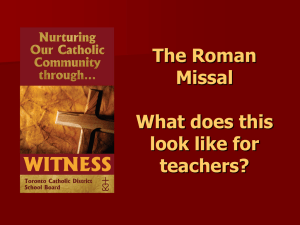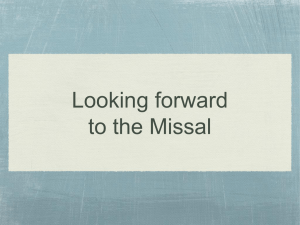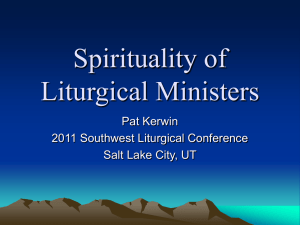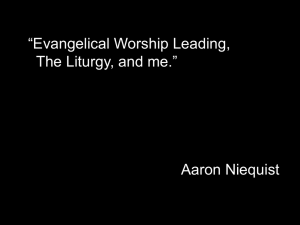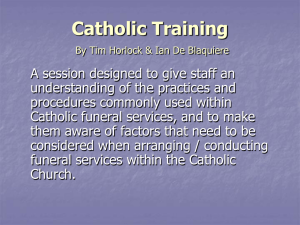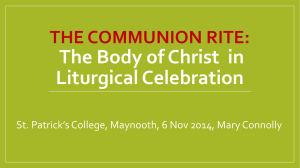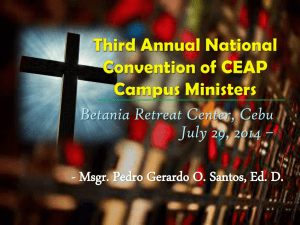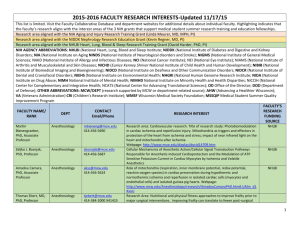Document
advertisement
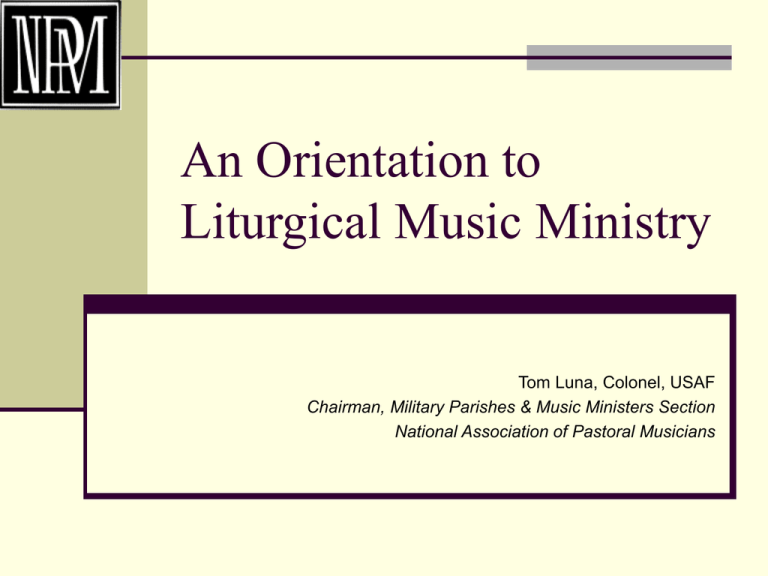
An Orientation to Liturgical Music Ministry Tom Luna, Colonel, USAF Chairman, Military Parishes & Music Ministers Section National Association of Pastoral Musicians Purpose Orient or refresh liturgical music ministers Understand our role(s) better Understand select elements of the new General Instruction of the Roman Missal (GIRM) Roman Missal = Lectionary + Sacramentary Here now: new English language instruction To come: new English language missal Liturgical law references for music CSL - Constitution on the Sacred Liturgy (Sacrosanctum Concilium), 1963 MCW - Music in Catholic Worship, 1972 (1983) LMT - Liturgical Music Today, 1982 GIRM - General Instruction of the Roman Missal (Third Typical Edition), 2002 “[choir members] must be trained to perform their functions in a correct and orderly manner.” (CSL, no. 29) Outline Ten Principles for Liturgical Ministers Why is music important? Role of the Assembly Methods Parts of the Mass (music perspective) Choice of Music Ten Principles for Liturgical Ministers [from: Celebration: Theology, Ministry and Practice, Eugene A. Walsh, © 1994 OCP Publications] We are members of the assembly. Effective ministers give life to the assembly; ineffective ministers deprive the assembly of life. Individual liturgical ministry is always a matter of service, never a matter of status or privilege. Ministry is a dialogue, a two-way communication. Individual ministers are competent in the skills of their ministry. Ten Principles for Liturgical Ministers – Cont. Effective ministers work as a team with other ministers to help give the celebration shape and dynamic. Effective ministers deliberately put out energy. Each person exercises only one ministry at a particular celebration. All ministers are accountable to the parish community. Each minister is a person of faith and prayer. Why Music? “The Christian faithful who gather together as one to await the Lord’s coming are instructed by the Apostle Paul to sing together psalms, hymns, and spiritual songs (cf. Col 3:16). Singing is the sign of the heart’s joy (cf. Acts 2:46). Thus St. Augustine says rightly, ‘Singing is for one who loves.’ There is also the ancient proverb: ‘One who sings well prays twice.’” (GIRM, no. 39) Why Music? “Faith grows when it is well expressed in celebration. Good celebrations foster and nourish faith. Poor celebrations may weaken and destroy it.” (MCW, no. 6) Why Music? “Among the many signs and symbols used by the Church to celebrate its faith, music is of preeminent importance... it forms a necessary or integral part of the solemn liturgy. Yet the function of music is ministerial; it must serve and never dominate. Music should assist the assembled believers to express and share the gift of faith that is within them and to nourish and strengthen their interior commitment of faith. It should heighten the texts... The quality of joy and enthusiasm which music adds to community worship cannot be gained in any other way. It imparts a sense of unity to the congregation and sets the appropriate tone for a particular celebration.” (MCW, no. 23) Why Music? “...music can also unveil a dimension of meaning and feeling, a communication of ideas and intuitions which words alone cannot yield. This dimension is integral to the human personality and to growth in faith. It cannot be ignored if the signs of worship are to speak to the whole person.” (MCW, no. 24) The Assembly and Music “...will be best accomplished if... it leads to a conscious, active, and full participation of the faithful both in body and in mind... and to which the Christian people have a right and duty by reason of their baptism.” (GIRM, no. 18) “...the utmost care must be taken to choose and to arrange those forms and elements set forth by the Church that, in view of the circumstances of the people and the place, will more effectively foster active and full participation”. (GIRM, no. 20) “All means must be used to promote singing by the people.” (MCW, no. 40) How Do We Get There: Methods We are members of the assembly... Minimize movement and other distractions shuffling music drinking talking if the assembly is singing, does the choir/cantor need to be amplified – except to accompany? “...and members of the choir also exercise a genuine liturgical function. They ought to discharge their office, therefore, with the sincere devotion and decorum demanded by so exalted a ministry and rightly expected of them by God’s people.” (CSL, no. 29) Methods Our music must be good or it will hurt the celebration It serves us better to consider ourselves ministers rather than performers Our main role is to support the assembly’s prayerful song “...liturgy is a prayer for all present, not a theatrical production.” (MCW, no. 82) “While there is no place in the liturgy for display of virtuosity for its own sake, artistry is valued...” (MCW, no. 35) Methods Pray it/proclaim it – don’t just sing it …but don’t make it a performance Diction – the words need to be understood Eye contact with the assembly – good! Cantor/psalmist/leader of song: gestures help the assembly know when to sing Other movements during songs may draw inappropriate attention to the choir “...it is necessary that the psalmist have the ability for singing and a facility in correct pronunciation and diction.” (GIRM, no. 102) Methods: Harmony The role of harmony.... Remember the role of assembly participation! Harmony on songs the assembly knows and sings well enhances the assembly’s song Harmony on songs the assembly is less familiar with often confuses them and detracts from their song prayer “Harmony is desirable when, without confusing the people, it gives breadth and power to their voices in unison.” (MCW, no. 75) Methods Function of the ambo... “From the ambo only the readings, the responsorial Psalm, and the Easter Proclamation (Exsultet) are to be proclaimed; it may be used also for giving the homily and for announcing the intentions of the Prayer of the Faithful. The dignity of the ambo requires that only a minister of the word should go up to it.” (GIRM, no. 309) Psalmists proclaim the word It is proper that they proclaim it from the ambo Parts Functions of music (from Janco): Punctuates prayer or ritual action Accompanies an action Gloria; Psalm; Holy Holy Covering/bridging Processions; Lamb of God Music is the focus Acclamations Preparation of the gifts; recessional Encourages meditation Prelude; song of praise; postlude Acclamations “The acclamations are shouts of joy which arise from the whole assembly as forceful and meaningful assents to God’s Word and Action. They are important because they make some of the most significant moments of the Mass... stand out. ...The people should know the acclamations by heart in order to sing them spontaneously.” (MCW, no. 53) “…acclamations… ought to be sung even at Masses in which little else is sung: Alleluia; ‘Holy, Holy, Holy Lord’; Memorial Acclamation; Great Amen…” (MCW, no. 54) Mass Structure Introductory Rites Liturgy of the Word Liturgy of the Eucharist Concluding Rite Prelude Silence vs meditation music vs teaching music... Some people best prepare for Mass in silence Some people best prepare for Mass with meditation music This is probably the best time to teach the assembly new music Best to find a balance? Introductory Rites Entrance Song – 4 purposes Opens the celebration Fosters unity among the gathered Directs thoughts to the mysteries of the liturgical season or festivity Accompanies the procession (GIRM, no. 47) “The two processional chants – the entrance song and the communion song – are very important for creating and sustaining an awareness of community.” (MCW, no. 60) Introductory Rites Penitential rite or Sprinkling rite May be sung Sprinkling rite often replaces penitential rite during Easter season Gloria May be sung by Everyone together Choir alone Assembly alternating with the choir May be recited – either by all or by two parts of the assembly responding to one another “The text of this hymn may not be replaced by any other text.” (GIRM, no. 53) Liturgy of the Word Psalm Gospel Acclamation Intercessions Liturgy of the Word Psalm “...an integral part of the Liturgy of the Word and holds great liturgical and pastoral importance, because it fosters meditation on the word of God.” (GIRM, no. 61) “It is preferable that the responsorial Psalm be sung, at least as far as the people’s response is concerned... from the ambo or another suitable place.” (GIRM, no. 61) ‘...it is unlawful to substitute other, non-biblical texts for the readings and responsorial Psalm, which contain the word of God.” (GIRM, no. 57) “Songs or hymns may not be used in place of the responsorial Psalm.” (GIRM, no. 61) [Must be a musical setting of the psalm itself – not simply a song based on the psalm ] Psalmist vs cantor – a psalmist should be a special cantor; psalmists proclaim the Word – similar to a lector. Liturgy of the Word Psalm Gospel Acclamation Should be sung Intercessions May be sung Liturgy of the Eucharist Preparation of the Gifts (Offertory) “The procession bringing the gifts is accompanied by the Offertory chant, which continues at least until the gifts have been placed on the altar. ...Singing may always accompany the rite at the offertory, even when there is no procession with the gifts. (GIRM, no. 74) Liturgy of the Eucharist “...the Eucharistic Prayer, which is the high point of the entire celebration” (GIRM, no. 30) Eucharistic Prayer Holy Holy [Sanctus] Memorial Acclamation May be sung or said (GIRM, no. 79) Should be sung Great Amen Should be sung Liturgy of the Eucharist: Communion Communion Rite Lord’s Prayer May be sung Lamb of God Continue until the priest completes fractioning the host “This invocation accompanies the fraction and, for this reason, may be repeated as many times as necessary until the rite has reached its conclusion, the last time ending with the words dona nobis pacem (grant us peace). (GIRM, no. 83) Liturgy of the Eucharist: Communion “While the priest is receiving the Sacrament, the Communion chant is begun. Its purpose is to express the communicants’ union in spirit by means of the unity of their voices, to show joy of heart, and to highlight more clearly the ‘communitarian’ nature of the procession to receive Communion. The singing is continued for as long as the Sacrament is being administered to the faithful.” (GIRM, no. 86) “The communion song should foster a sense of unity. It should be simple and not demand great effort.” (MCW, no. 62) Assembly should be able to sing without hymnal Songs with refrains work well Responsorial format work well Traditional metrical hymns don’t have refrains; generally don’t work well at communion unless all verses well known Liturgy of the Eucharist: Communion The communion song ends after all have received communion This may be followed by: Meditative silence Song of praise After Concluding Rite Sending Forth Music is optional but works well! Most assemblies like to conclude singing but… May be choir alone, may be instrumental, may be silence There’s lots of flexibility here Postlude (optional) A good opportunity for choir-only songs Choice of Music “To determine the value of a given musical element in a liturgical celebration a threefold judgment must be made: musical, liturgical, and pastoral.” (MCW, no. 25) Choice Musical Is it good musically? Mass setting: should be consistent throughout the Mass liturgically and pastorally, it can and should change with the seasons but should be consistent year to year The assembly needs to know this music by heart! Liturgical Does it fit the ritual/rite? the readings of this Mass? the season? Pastoral Does it fit what the assembly may be dealing with in their lives outside of Mass? Choice “...arrange those forms and elements set forth by the Church that, in view of the circumstances of the people and the place, will more effectively foster active and full participation”. (GIRM, no. 20) “The congregation must be comfortable and secure with what they are doing in order to celebrate well.” (MCW, no. 34) Choice Repetition encourages participation Most music clinicians recommend limiting new songs to 3 or 4/year – although musicians always want more Introduce only 1 new song at a time and repeat it at least 3 or 4 times over the first 2 months Mass settings should be stable over years (though may vary by seasons) “...songs correspond as closely as possible to the needs, religious dispositions, and aptitude of the participants... The music used should be within the competence of most of the worshipers. It should suit their age-level, cultural background, and level of faith.” (MCW, no.15) Choice Instrumentation Altered instrumentation can help differentiate between seasons Advent & Lent season instrumentation are more spare Pull out all the stops for the Easter & Christmas seasons “In Advent the organ and other musical instruments should be used with a moderation that is consistent with the season’s character and does not anticipate the full joy of the Nativity of the Lord.” “In Lent the playing of the organ and musical instruments is allowed only to support the singing. Exceptions are ...” (GIRM, no. 313) Instrumental music can be appropriate as a prelude, at preparation of the gifts, and at the recessional. (MCW, no. 37) [note: the new GIRM implies that the assembly should sing at the preparation of the gifts] Choice GIRM emphasis areas: Psalms Acclamations Processionals (especially opening & communion) Silence More singing! Choice Bottomline: “Does music in the celebration enable these people to express their faith, in this place, in this age, in this culture?” (MCW, no. 39) Questions? Contact Col Tom Luna or others at NPM via: www.NPM.org
